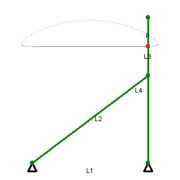- Chebyshev linkage
-
The Chebyshev linkage is a mechanical linkage that converts rotational motion to approximate straight-line motion.
It was invented by the 19th century mathematician Pafnuty Chebyshev who studied theoretical problems in kinematic mechanisms. One of the problems was the construction of a linkage that converts a rotary motion into an approximate straight line motion. This was also studied by James Watt in his improvements to the steam engine.[1]
The straight line linkage confines the point P — the midpoint on the link L3 — on a straight line at the two extremes and at the center of travel. (L1, L2, L3, and L4 are as shown in the illustration.) Between those points, point P deviates slightly from a perfect straight line. The proportions between the links are
Point P is in the middle of L3. This relationship assures that the link L3 lies vertically when it is at the extremes of its travel.[2]
The lengths are related mathematically as follows:
See also
- Watt's linkage, a similar straight-line mechanism with the direction of one of the arms reversed.
- Straight line mechanism
- Hoekens linkage
- Peaucellier–Lipkin linkage
- Four-bar linkage
References
- ^ Cornell university - Cross link straight-line mechanism
- ^ Brock institute for advanced studies - Tchebicheff's linkage
External links
- Cornell university, "How to draw a straight line, by A.B. Kempe, B.A."
- A simulation using the Molecular Workbench software
Categories:- Linkages
- Technology stubs
Wikimedia Foundation. 2010.



